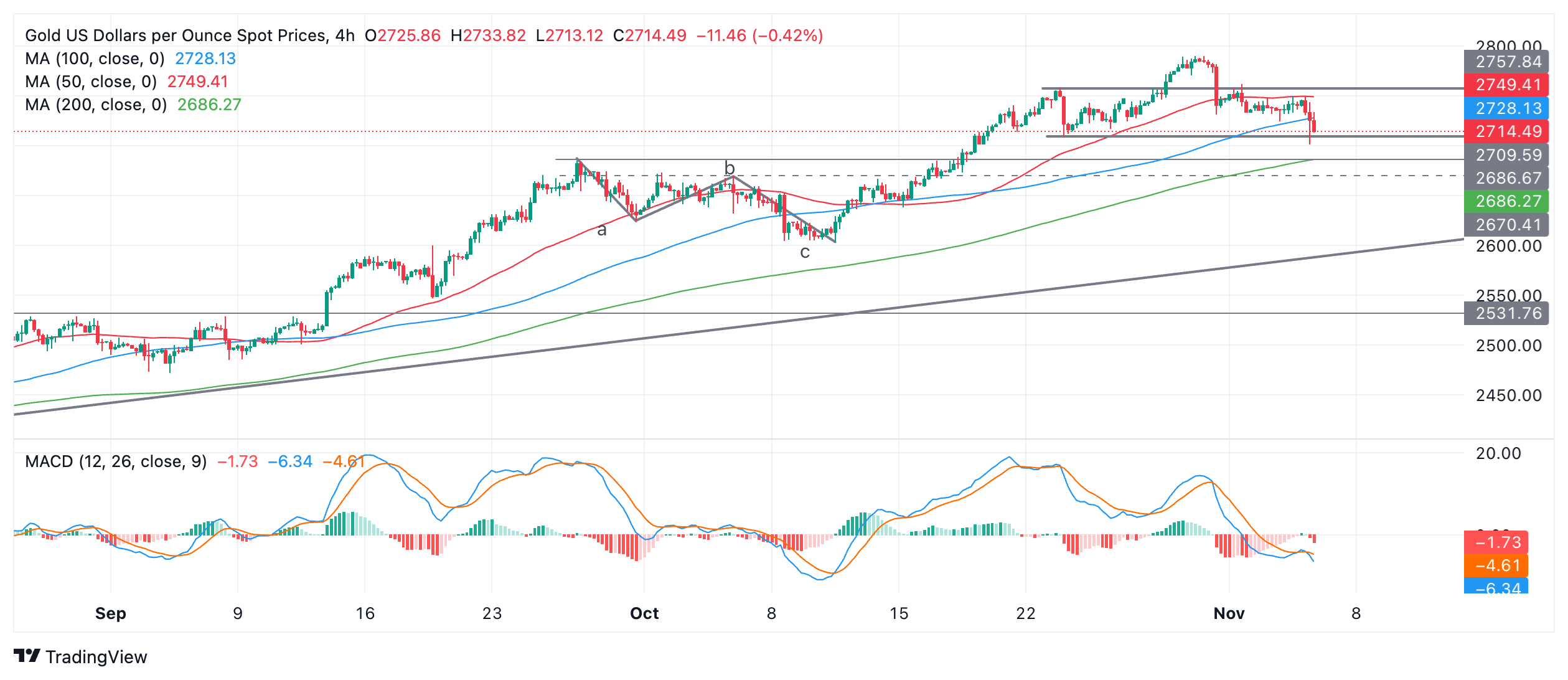Gold dumped for riskier options as Trump elected president

- Gold falls out of favor as capital piles into the US Dollar, Bitcoin and Stocks.
- Donald Trump is now expected almost certainly to be the next US President.
- Technically, XAU/USD extends its short-term downtrend to key support.
Gold (XAU/USD) trades down by a percentage point in the $2,710s on Wednesday due to the US Dollar (USD) strengthening after Republican nominee Donal Trump was named the winner of the US presidential election. Trump won with 277 electoral college votes over Vice President Kamala Harris’ 224, according to the Associated Press. USD is gaining due to the market view that Donald Trump’s economic agenda and tariffs will strengthen the US Dollar. This, in turn, is negative for Gold since it is mainly priced and traded in USD.
Gold is also losing ground due to capital rotating out of Gold and other safe-havens into riskier assets such as Bitcoin (BTC) and equities.
Trump’s claims that he can end the conflicts in the Middle East and Ukraine, though seemingly exaggerated (“I will have that war (Ukraine-Russia) settled in one day – 24hrs,” Trump once said), could also be reducing safe-haven flows into Gold.
Gold losses out as Trump trade fully materializes
Gold loses out to the US Dollar, Bitcoin and US stock index futures as markets celebrate the expected victory of Donald Trump in the US presidential election.
The US Dollar Index (DXY) rose over 1.3% to a peak of 105.32 on Wednesday as it became clear Trump was almost certain of winning.
US stock futures were also up during Wednesday’s European session, with the S&P 500 futures contract up 2.2% at 5,909 in pre-market trading and the Dow 30 futures contract up over 1.3% to 42,770, as markets rejoiced in anticipation of Trump’s likely lower tax agenda.
Likewise, Bitcoin rose to a new all-time high of $75,407 due to the looser regulatory environment for crypto promised by Trump.
The pivot back into the US Dollar, Bitcoin and stocks, however, saw capital flow out of bonds and commodities, with US Treasuries, Gold, Oil, Silver and Copper all falling.
Technical Analysis: XAU/USD finds support at key level
Gold falls to support at $2,709, the base of a former range, as it trends lower. The precious metal is probably now in a short-term downtrend and, given the principle that “the trend is your friend,” it is vulnerable to further weakness in the near term.
XAU/USD 4-hour Chart
A break below the range and the daily low at $2,701 would confirm a lower low and further weakness. Such a move would probably fall to the next support level at $2,687, the September 26 swing high.
The Relative Strength Index (RSI) is falling in line with price, suggesting bearish pressure accompanies the downward trend.
That said, the precious metal remains in an uptrend on a medium and long-term basis, and a material risk remains that it could reverse course and begin rising in line with these broader up cycles. However, there are no technical signs of this happening yet.
A break above the all-time high of $2,790 would re-confirm the medium-term uptrend and probably lead to a move up to resistance at $2,800 (whole number and psychological number), followed by $2,850.
Gold FAQs
Gold has played a key role in human’s history as it has been widely used as a store of value and medium of exchange. Currently, apart from its shine and usage for jewelry, the precious metal is widely seen as a safe-haven asset, meaning that it is considered a good investment during turbulent times. Gold is also widely seen as a hedge against inflation and against depreciating currencies as it doesn’t rely on any specific issuer or government.
Central banks are the biggest Gold holders. In their aim to support their currencies in turbulent times, central banks tend to diversify their reserves and buy Gold to improve the perceived strength of the economy and the currency. High Gold reserves can be a source of trust for a country’s solvency. Central banks added 1,136 tonnes of Gold worth around $70 billion to their reserves in 2022, according to data from the World Gold Council. This is the highest yearly purchase since records began. Central banks from emerging economies such as China, India and Turkey are quickly increasing their Gold reserves.
Gold has an inverse correlation with the US Dollar and US Treasuries, which are both major reserve and safe-haven assets. When the Dollar depreciates, Gold tends to rise, enabling investors and central banks to diversify their assets in turbulent times. Gold is also inversely correlated with risk assets. A rally in the stock market tends to weaken Gold price, while sell-offs in riskier markets tend to favor the precious metal.
The price can move due to a wide range of factors. Geopolitical instability or fears of a deep recession can quickly make Gold price escalate due to its safe-haven status. As a yield-less asset, Gold tends to rise with lower interest rates, while higher cost of money usually weighs down on the yellow metal. Still, most moves depend on how the US Dollar (USD) behaves as the asset is priced in dollars (XAU/USD). A strong Dollar tends to keep the price of Gold controlled, whereas a weaker Dollar is likely to push Gold prices up.
